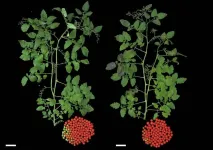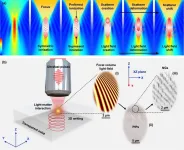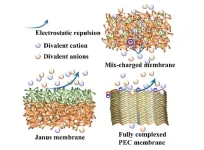(Press-News.org) AMR is when microorganisms that cause infections, such as bacteria and viruses, change over time and no longer respond to antibiotic medicines.
It makes serious conditions such as HIV, tuberculosis and malaria more difficult to treat and increases the risk of severe illness, disease spread and death.
AMR particularly impacts low-to-middle-income countries where water quality is often poor and the spread environmental spread of AMR via wastes can be high.
In 2015 the World Health Organization (WHO) formulated a Global Action Plan to co-ordinate efforts to tackle AMR.
As a result, 194 WHO member states committed to developing country-specific One Health AMR National Action Plans (NAPs).
The One Health model recognises the interconnection between people, animals, plants, and their shared environment.
However, inadequate logistical capacity, funding, and poor access to essential information can hinder informed NAP policymaking, especially in low-to-middle-income countries.
Now an international team of researchers, co-led by Professor Yong-Guan Zhu from the Chinese Academy of Sciences and Professor David Graham from Durham University, UK, has created an AI tool to bridge critical gaps in knowledge needed for informal policy development and to assist in the preparation of National Action Plans.
The research has been published in the journal Environmental Science & Technology.
The large language model tool developed by the research team, called the AMR-Policy GPT, contains information from AMR-related policy documents from 146 countries.
It works in similar way to established AI chatbots such as ChatGPT but has a focusing element that encourages more current, accurate, and contextually relevant information on AMR compared with more generic chatbots.
Professor David Graham of Durham University’s Department of Biosciences, said: “We believe our prototype is a valuable starting point for National Action Plans, especially for parts of the world that lack local data or infrastructure to support integrated action against AMR.
“Any solutions to do with global health need to be viewed holistically and our tool will help guide AMR policy development by increasing knowledge-sharing across countries worldwide, especially related to the environmental spread of AMR.
“Essentially, it provides decision makers with well-referenced information from across all disciplines at their fingertips.
“And with the ability to continuously update, our framework ensures that the chatbot tool remains up-to-date and effective.”
The researchers stress that the primary purpose of AMR-Policy GPT is an ‘intelligent’ information source to assist in the policymaking process - like having a smart friend in the room, and it is not designed to write comprehensive NAPs.
The researchers will continue to build on the prototype and explore how it can be further improved and expanded following feedback from users.
In the future they would like to integrate even more scientific knowledge with policy information to create an enhanced AMR-Policy GPT.
Professor Zhu said: “Given the enormous and growing volume of information on AMR and its possible influence on policy, we think that AI is an excellent tool for knowledge integration and also for the initial distillation of understanding.”
Also included in the study were researchers from Shanghai Jiao Tong University in China and Johns Hopkins Bloomberg School of Public Health in the USA.
ENDS
Media Information
The AMR-Policy GPT tool is freely available for the public to use and can be accessed via the following link: AMR-Policy GPT
Professor David Graham of Durham University’s Department of Biosciences is available for interview and can be contacted at david.w.graham@durham.ac.uk
Alternatively, please contact Durham University Communications Office for interview requests on communications.team@durham.ac.uk.
Source information
The full paper ‘Using Large Language Models to Assist Antimicrobial Resistance Policy Development: Integrating the Environment into Health Protection Planning’ Cai Chen, Shu-Le Li, Anthony D. So, Yao-Yang Xu, Zhao-Feng Guo, Xinbing Wang, David W. Graham, Yong-Guan Zhu, is published in the journal Environmental Science & Technology.
It will be available once the embargo lifts via the DOI link: https://doi.org/10.1021/acs.est.4c07842
An advance copy of the paper is available, under embargo. To request a copy, contact the journal publishers at Newsroom@acs.org
About Durham University
Durham University is a globally outstanding centre of teaching and research based in historic Durham City in the UK.
We are a collegiate university committed to inspiring our people to do outstanding things at Durham and in the world.
We conduct research that improves lives globally and we are ranked as a world top 100 university with an international reputation in research and education (QS World University Rankings 2024).
We are a member of the Russell Group of leading research-intensive UK universities and we are consistently ranked as a top 10 university in national league tables (Times and Sunday Times Good University Guide, Guardian University Guide and The Complete University Guide).
For more information about Durham University visit: www.durham.ac.uk/about/
END OF MEDIA RELEASE – Issued by Durham University Marketing and Communications Office
END
Harnessing AI to respond to the global threat of antimicrobial resistance
2025-01-08
ELSE PRESS RELEASES FROM THIS DATE:
New findings may help researchers develop a grapefruit devoid of compounds that affect medication levels
2025-01-08
Grapefruit and pummelo contain compounds called furanocoumarins that may affect the blood levels of more than 100 prescription drugs, so that people taking these medications are advised to remove these fruits from their diets. Research published in New Phytologist reveals genetic information about the synthesis of furanocoumarins in different citrus plant tissues and species and provides new insights that could be used to develop grapefruit and pummelo that lack furanocoumarins.
The research indicates that the production of furanocoumarins in citrus ...
Advanced wearable robot eases heavy lifting and other injury-causing tasks for workers
2025-01-08
In research published in Advanced Intelligence Systems, scientists have developed an innovative, soft, wearable robot to help workers avoid job-related injuries while lifting, lowering, and carrying objects.
While many available wearable robots are limited to supporting a single degree of freedom of the body (meaning the body can only move in one direction at a given joint), the new robot, called WeaRo, operates through multiple degrees of freedom, allowing for complex movements.
In tests, WeaRo effectively reduced the muscle activation levels of lumbar, biceps, and triceps muscles by a maximum of 18.2%, 29.1%, and ...
Does job strain compromise long-term sleep quality?
2025-01-08
In a recent study published in the American Journal of Industrial Medicine, middle aged workers in the U.S. who reported high job strain at the start of the study experienced significantly more sleep disturbances over an average follow-up of nine years.
The study analyzed data from 1,721 workers, with an average age of 51 years, who participated in the Midlife in the United States (MIDUS) study. Sleep disturbances were assessed with an established scale, based on four sleep-related symptoms: trouble falling asleep, waking up during ...
Artificial intelligence–based method assesses depression in business leaders
2025-01-08
Researchers have developed a novel method to assess depression in CEOs by using machine learning models (a type of artificial intelligence) to analyze vocal acoustic features from conference call recordings. This innovative approach, detailed in an article published in the Journal of Accounting Research, provides insights into a mental health issue that often remains hidden in high-pressure executive roles.
The researchers examined how CEO depression is related to career outcomes, compensation, and incentives. Their findings suggest ...
Study assesses the benefits of alfalfa-almond intercropping
2025-01-08
The practice of growing different but complementary plants within a given area, also known as intercropping, has numerous positive effects such as reduced soil erosion, weed suppression, nitrogen fixation (the conversion of atmospheric nitrogen to nitrogen compounds that can be used by plants and other organisms), and pollinator benefits. New research published in Agrosystems, Geosciences & Environment reveals the increased land use efficiency and environmental benefits in an alfalfa–almond intercropped ecosystem ...
Mediterranean sharks continue to decline despite conservation progress
2025-01-08
Overfishing, illegal fishing and increasing marketing of shark meat pose significant threats to the more than 80 species of sharks and rays that inhabit the Mediterranean Sea, according to a new study.
The research examined current levels of legislation in place to protect elasmobranch populations (which include sharks, rays and skates) within each of the 22 coastal states of the Mediterranean region.
Across those countries – stretching from Spain and Morocco in the west to Israel, Lebanon and Syria in the east – the researchers identified more than 200 measures that concern elasmobranchs in some ...
New treatment option for severe hypertrophic cardiomyopathy in children shows promise
2025-01-08
Trametinib, a mitogen-activated protein kinase (MEK) inhibitor, reduces mortality and morbidity in children with severe hypertrophic cardiomyopathy (HCM) caused by pathogenic variants in the RAS/MAPK pathway, according to a study published today in JACC: Basic to Translational Science. The study provides strong evidence for personalized treatment targeting the underlying genetic causes of RASopathies, a group of rare disorders that often lead to life-threatening cardiac complications.
“Our findings represent a breakthrough in the treatment of HCM in children, particularly those suffering from severe forms of the disease due to genetic variants in the RAS/MAPK ...
Repairing a domestication mutation in tomato leads to an earlier yield
2025-01-08
Genome editing with CRISPR-Cas is often associated with the induction of mutations. However, a team of researchers from the Swiss University of Lausanne now shows that it can also be used to repair natural mutations.
All living organisms mutate, which is a major driver of biodiversity and evolution. Humans have been domesticating plants for thousands of years, by selecting mutations that lead to favorable characteristics such as larger or more numerous fruits. However, this process often caused the ...
Focal volume optics for composite structuring in transparent solids
2025-01-08
For a long time, an ultrafast laser has been applied as a point-typed energy source to trigger various material modifications, and the profile of light intensity is mainly considered a Gaussian type. Therefore, the actual morphology and evolution of the light field in the focal volume have been overlooked.
In International Journal of Extreme Manufacturing, researchers indicates that the 3D spatial distribution of the light field at the focus can possess finer structures and is tunable, which offers a novel strategy for highly controllable micro-nano fabrication with more degrees of freedom beyond conventional point-by-point optical modification.
It is proposed and experimentally demonstrated ...
Novel mix-charged nanofiltration membrane developed for high-salinity wastewater treatment
2025-01-08
A research team led by Prof. WAN Yinhua at the Institute of Process Engineering (IPE) of the Chinese Academy of Sciences has recently developed an innovative mix-charged nanofiltration (NF) membrane featuring horizontal charge distribution, designed specifically for wastewater treatment. This novel membrane exhibits remarkable salt permeation and organic matter retention capabilities as well as antifouling properties, making it particularly effective for treating high-salinity organic wastewater.
The findings ...



